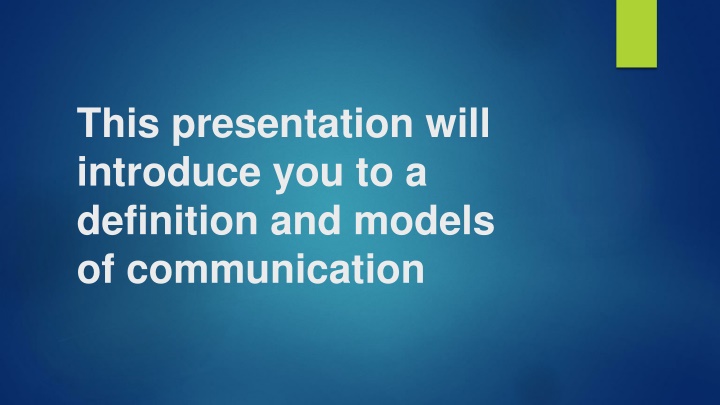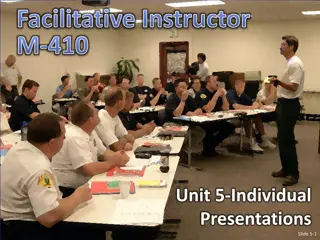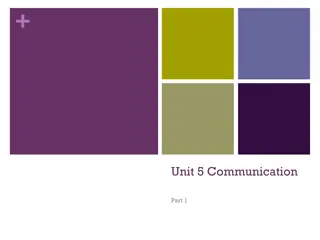
Communication: Definition and Models Explored
Explore the definition of communication, its importance, and various models including the linear model by Shannon and Weaver. Discover the different types of communication and its impact on relationships and society.
Uploaded on | 1 Views
Download Presentation

Please find below an Image/Link to download the presentation.
The content on the website is provided AS IS for your information and personal use only. It may not be sold, licensed, or shared on other websites without obtaining consent from the author. If you encounter any issues during the download, it is possible that the publisher has removed the file from their server.
You are allowed to download the files provided on this website for personal or commercial use, subject to the condition that they are used lawfully. All files are the property of their respective owners.
The content on the website is provided AS IS for your information and personal use only. It may not be sold, licensed, or shared on other websites without obtaining consent from the author.
E N D
Presentation Transcript
This presentation will introduce you to a definition and models of communication
A definition of communication Many definitions exist in education, research and practice. For the purpose of this theme: Communication refers to the process of human beings responding to the symbolic behaviour of other persons (Adler and Rodman, 2006, p. 4) symbolic what one person s behaviour means or represents to the other. This may be the same or different to that intended.
We all have needs that are linked to communication: (Adler and Rodman, 2006) Physical needs social isolation can contribute towards poor health; supportive communication is essential for our wellbeing. Identity needs our sense of identity (including our uniqueness) and the development of our personal identity stems from our interaction with others. Social needs we have a need for positive secure and healthy attachments that support our inclusion. Practical needs we need to communicate to survive.
Adler and Rodman (2006) apply this definition to: One-to-one communication (two people) Small group communication (e.g. family, friends, discussions in a residential environment) Public communication (e.g. public speaking, political party conferences) Mass communication (via electronic and print media, e.g. international news channel)
Communication may take place between: Parent(s) and child/children Siblings Children and adults in residential settings Personal relationships Managers and employees Individuals and service providers Retailers and purchasers Friends Strangers Work colleagues Professionals in multi disciplinary teams Organisational representatives at strategy meetings Groups, members of the public and the mass media
Linear model of communication (Shannon and Weaver, 1949) conveys a situation where one does to another
This is a linear model of communication (Shannon and Weaver, 1949) where one does to another: The Sender encodes ideas and feelings into a message (expresses what they want to say in their own code or way of expressing themselves, including their language). The Receiver decodes the message.
Linear model of communication (Shannon and Weaver, 1949) where one does to another The Communication channel is the method in which the message is transmitted (put across). Mediated communication channels your message via some form of medium, e.g. telephone, email, face to face. The medium can influence the effect of the message, for example: - emails with exclamation !!!!!
Linear model of communication (Shannon and Weaver, 1949) where one does to another This model presents three types of noise that can interfere with effective communication: - External or physical, e.g. traffic noise, loud music - Physiological, e.g. if the sender or receiver of the message feels unwell or tired that day - Psychological, e.g. if the sender or receiver is upset this may interfere with their ability to communicate effectively
Linear model of communication (Shannon and Weaver, 1949) where one does to another For example, the concept of noise can be applied to the following scenario: You are a support worker who has called in to visit John to discuss a care and support plan. John wants to leave home eventually. You walk in and sit down. There has been a massive family argument. John has demanded more privacy and independence from his parents. John s parents are frustrated by his rudeness towards them and have told him he needs to respect them. Everyone is upset. You could consider the three types of noise in this situation (physical, physiological and psychological) and how they may impact on your work. The noise is likely to affect communication between: John His parents You as the support worker
Linear model of communication (Shannon and Weaver, 1949) where one does to another: Environment communicators often occupy different environments which refer to: Physical location Personal experiences Cultural backgrounds
Barnlund (1970) built upon the Shannon and Weaver model (1949) to present a transactional model of communication
In contrast to the previous model, (Barnlund, 1970) cites communication as a two way exchange Barnlund s (1970) model proposes that communication is reliant on how people interact with each other, i.e. communication is with people and not to them. Therefore, communicators send and receive messages simultaneously and there is feedback from the receiver to the messenger. This model takes non-verbal communication into account (e.g. facial expressions, gesture, posture, tone of voice). Noise and the environment continue to be relevant.
Transactional model of communication (Barnlund, 1970) a two way exchange This model can be applied to the concept of physical location, personal experiences, oppression and cultural background, for example: You are a worker who needs a hearing loop (provides a electromagnetic signal for a person with a hearing aid who is partially deaf) to be available when you attend multi agency meetings. These meetings are to discuss a health and wellbeing strategy for the local authority. You attend a meeting and arrangements have not been made for the hearing loop to be on. How do you feel in terms of your physical location, personal experience and cultural background at that meeting?
Thompson (1997;2006) PCS model Thompson (1997;2006) presents a model for how people working in sectors such as social care and health can treat people with respect and challenge disadvantage and discrimination. Personal Cultural Social
Thompsons model (1997; 2006) proposes that people working in sectors such as social care and health should treat people with respect and challenge disadvantage and discrimination by understanding and acting upon the person s personal, cultural and social factors: Personal Cultural Social Our individuality and uniqueness comes from personal, cultural and structural (social) influences that come together within our lives. This can impact on the extent to which we feel part of our community. The personal aspects of an individual are surrounded (influenced) by cultural and structural influences. Cultural influences include shared approaches to situations, i.e. what is considered to be acceptable behaviour within a person s group; for example, excluding one s daughter from school may be seen as deviant by society as a whole but acceptable within a particular family network think about the message that culture would convey to the girl excluded from school; also, think back to the person who attended the meeting where there was no hearing loop and how this impacted on their feeling of inclusion.
Thompsons model (1997; 2006) proposes that people working in sectors such as social care and health should treat people with respect and challenge disadvantage and discrimination by understanding and acting upon the person s personal, cultural and social factors: Personal Cultural Social Structural influences refer to how society as a whole operates in terms of government policy and societal attitudes and behaviours think back to your work on equality and diversity and how legislation can represent shifts in societal attitudes. This is why there are now nine protected characteristics (disability; gender reassignment; marriage and civil partnership; pregnancy and maternity; race; religion and belief; sex; sexual orientation) identified in the Equality Act 2010 if you went back forty years the majority of characteristics were not protected which shows how times have changed.
Thompsons model (1997; 2006) proposes that people working in sectors such as social care and health should treat people with respect and challenge disadvantage and discrimination by understanding and acting upon the person s personal, cultural and social factors: Personal Cultural Social When we communicate with individuals requiring social care and health services, we need to understand how individuals are affected by social and other factors. We should act on this understanding to challenge disadvantage and prejudice so that we respect uniqueness, dignity, equality and diversity. Individuals are more likely to have confidence in us and others so that they can develop positive and trusting relationships.
Based on these models, examples of effective communication in social care and health include: Active listening Advising Advocacy Anti-discriminatory practice Assertiveness Assessment Conflict management Empathy Emotional intelligence Empowerment MOSS (2012)
References Adler, R. and Rodman, G. (2006) Understanding human communication. Ninth edition. New York:Oxford University Press. Barnlund, D. (1970) A transactional model of communication in Sereno, K. and Mortensen, D. (eds.) Foundations of communication theory. New York;London:Harper and Row, pp. 83-102. Moss, B. (2012) Communication skills in health and social care. London: Sage. Shannon, C. and Weaver, W. (1949) The mathematical theory of communication. London: University of Illinois Press. Thompson, N. (1997) Anti-discriminatory Practice. Second edition. Basingstoke: Macmillan. Thompson, N. (2006) Anti-discriminatory Practice. Fourth edition. Basingstoke: Macmillan.











